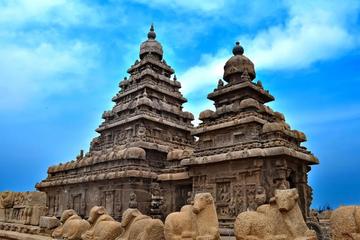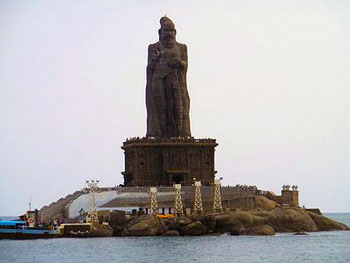
Kanyakumari, India
by R. Niranjan Das
There are very few places on this beautiful earth where one can witness both sunrise and sunset over the horizon. One amongst them is Cape Comorin which is the tip of Indian mainland. Cape Comorin which is better known as Kanyakumari is the place where the three humungous water bodies namely, Indian Ocean, Arabian Sea and Bay of Bengal meet up.
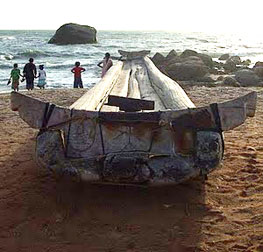 After travelling for about two hours from Thiruvananthapuram, we reached the tip of India. It is a crowded little place with shops and hawkers selling shells of various shapes and sands of different colours. A small boat ride from the mainland took us to the famous Vivekananda rock, where the great philosopher had meditated. There are a lot books about his teachings which can be purchased. Next to this, stands the massive statue of Thiruvalluvar, the Tamil philosopher and poet also known as Valluvar, which has been constructed on another rock. These two are in fact the main tourist destinations in Kanyakumari. On the way to these rocks we saw many rocks protruding out of the sea. It could possibly have been a part of the mainland many ages ago.
After travelling for about two hours from Thiruvananthapuram, we reached the tip of India. It is a crowded little place with shops and hawkers selling shells of various shapes and sands of different colours. A small boat ride from the mainland took us to the famous Vivekananda rock, where the great philosopher had meditated. There are a lot books about his teachings which can be purchased. Next to this, stands the massive statue of Thiruvalluvar, the Tamil philosopher and poet also known as Valluvar, which has been constructed on another rock. These two are in fact the main tourist destinations in Kanyakumari. On the way to these rocks we saw many rocks protruding out of the sea. It could possibly have been a part of the mainland many ages ago.
The beach was our next destination and witnessing the lovely sunset, the intention. The beach is covered with rocks at quite a few places and many tourists including myself climbed on to it to enjoy the colourful horizon and stare at the dipping sun. We kept gazing at the darkening horizon and enjoyed the moments of solitude. Having witnessed numerous sunsets and a few sunrises, I definitely feel that a sunset is more spectacular than a sunrise. Period.
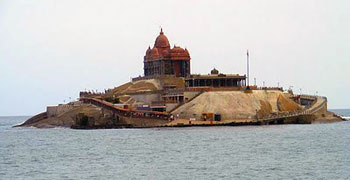 Another interesting attraction at Kanyakumari is the three different colours of the three bodies of water that you can see at one particular location. Shortage of time forced us to leave the same night back to Thiruvananthapuram and miss the next day’s beautiful sunrise. I would definitely like to come back to Kanyakumari some time soon and witness both the visual treats.
Another interesting attraction at Kanyakumari is the three different colours of the three bodies of water that you can see at one particular location. Shortage of time forced us to leave the same night back to Thiruvananthapuram and miss the next day’s beautiful sunrise. I would definitely like to come back to Kanyakumari some time soon and witness both the visual treats.
Kanyakumari is not a typical beach town as it has a rocky seafront. Travelers head to this lovely place to witness the spellbinding sunrises and the breathtaking sunsets. It is in fact a photographers paradise as it gives them the opportunity to capture the different shades of the sky as the sun rises and sets over the horizon. Witnessing the rising and the setting of the sun makes up for a serene holiday.
If You Go:
Location- Tamil Nadu, South India
Nearest Airport- Thiruvananthapuram Airport
Nearest bus stand and railway station- Kanyakumari
Best time to go- Throughout the year.
Other places of Interest- Thiruvananthapuram
Tours Now Available:
Day Tour to Kanyakumari from Nagercoil
Kovalam to Kanyakumari Full Day Trip
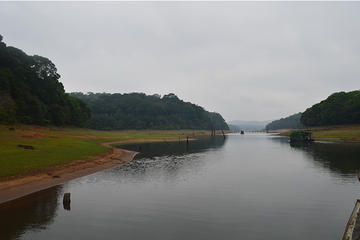
8 Days Kerala to Kanyakumari with Backwater Cruise and wildlife Private Tour
About the author:
R. Niranjan Das is a passionate traveller from Bangalore, India who loves exploring all kinds of destinations and experiencing various cultures. You can find his travelogues on his blog at: rajniranjandas.blogspot.com
Photo Credits:
All photos are by R. Niranjan Das.

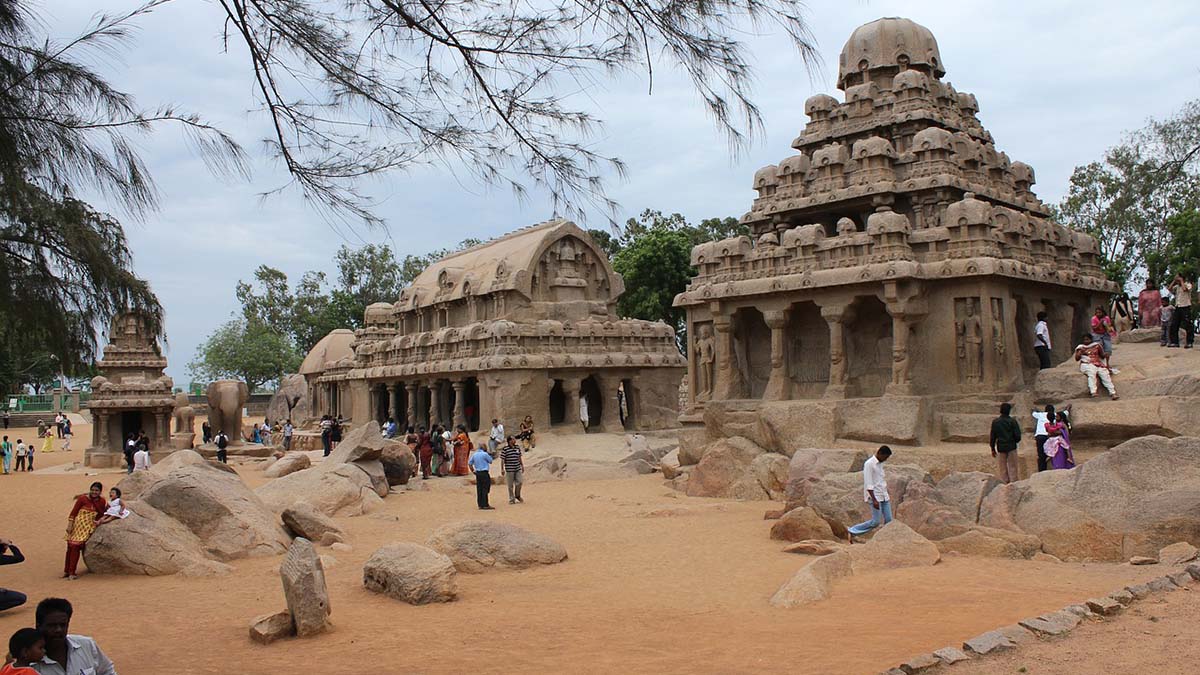
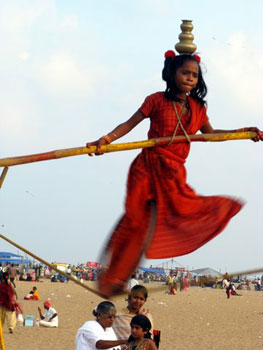 As my husband Rick and I plod through the soft sand, Coney Island comes to mind. Smiling tots bob up and down on carousels and youths shriek from wildly-whirling contraptions, horses gallop by with riders, and kites fill the sky. Most amazing are the girls aged between six and ten performing daring feats on tightropes affixed to crossed bamboo poles lodged in the sand. Snack food is sold out of tents and stalls, some with gaudy plastic stools out front for customers. We agree this is our most exhilarating beach walk to date.
As my husband Rick and I plod through the soft sand, Coney Island comes to mind. Smiling tots bob up and down on carousels and youths shriek from wildly-whirling contraptions, horses gallop by with riders, and kites fill the sky. Most amazing are the girls aged between six and ten performing daring feats on tightropes affixed to crossed bamboo poles lodged in the sand. Snack food is sold out of tents and stalls, some with gaudy plastic stools out front for customers. We agree this is our most exhilarating beach walk to date. St. Thomas (San Thome) Basilica (built in 1504, and rebuilt in 1893) is renowned for its neogothic elegance, and for an underground chapel where I stand riveted at the thought of “doubting Thomas”, one of the twelve Apostles of Christ being buried here. This is one of three churches in the world proclaimed to be built over the tomb of an Apostle (the others being St. Peter’s Basilica in Rome, and Cathedral of Santiago de Compostela built over the tomb of St. James in Spain).
St. Thomas (San Thome) Basilica (built in 1504, and rebuilt in 1893) is renowned for its neogothic elegance, and for an underground chapel where I stand riveted at the thought of “doubting Thomas”, one of the twelve Apostles of Christ being buried here. This is one of three churches in the world proclaimed to be built over the tomb of an Apostle (the others being St. Peter’s Basilica in Rome, and Cathedral of Santiago de Compostela built over the tomb of St. James in Spain).
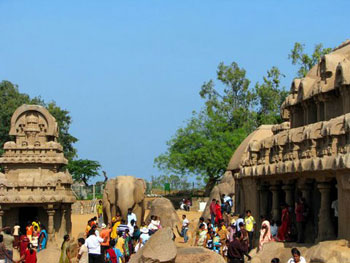 Dharma leads us to the 12m high and 30m wide exquisite bas relief known as Arjuna’s Penance. Dharma points out the key figure saying, “Arjuna is balanced on one leg with arms upraised in ‘penance’, which in the Hindu religion does not mean repentance, but rather a gaining of power over the gods.” Arjuna’s motive was to garner the sword from the towering figure of Shiva beside him, with which to kill his enemies. Our imaginations soar as our eyes scan the 100 sculptured forms surrounding the central figures, depicting lesser gods, humans, flying creatures, and animals, including two life-sized elephants.
Dharma leads us to the 12m high and 30m wide exquisite bas relief known as Arjuna’s Penance. Dharma points out the key figure saying, “Arjuna is balanced on one leg with arms upraised in ‘penance’, which in the Hindu religion does not mean repentance, but rather a gaining of power over the gods.” Arjuna’s motive was to garner the sword from the towering figure of Shiva beside him, with which to kill his enemies. Our imaginations soar as our eyes scan the 100 sculptured forms surrounding the central figures, depicting lesser gods, humans, flying creatures, and animals, including two life-sized elephants.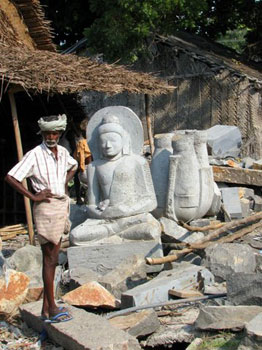 Over a thousand years later, the tapping of hammer and chisel continues along the dusty streets of this village renowned for its stone carving. We become absorbed watching artisans chip granite blocks into animal forms and gods destined for temples around the world.
Over a thousand years later, the tapping of hammer and chisel continues along the dusty streets of this village renowned for its stone carving. We become absorbed watching artisans chip granite blocks into animal forms and gods destined for temples around the world. Another Kanchipuram stop was to a family silk weaving factory where some of the most astoundingly beautiful wedding saris are made with vividly coloured silk threads, the borders spun with gold and silver strands, and costing up to 50,000 Rupees ($1,190) – expensive for the country’s economy. Eighty percent of the city’s population is involved in the silk industry.
Another Kanchipuram stop was to a family silk weaving factory where some of the most astoundingly beautiful wedding saris are made with vividly coloured silk threads, the borders spun with gold and silver strands, and costing up to 50,000 Rupees ($1,190) – expensive for the country’s economy. Eighty percent of the city’s population is involved in the silk industry. Just over the border from Puducherry is Auroville, the brainchild of “the Mother”, whose work has been carried on by her followers. Although there is minimal tourist access of the facility, a visitor centre provides information on the workings of this international community that is spread over 20 sq km, with about 2,000 residents from around 38 nations. It is a place to live in peace and unity – above all creeds, politics, and nationalities. The focal point of Auroville is a gigantic gold-plated globe called the Matrimandir, which contains a crystal that diffuses sunlight into 26 meditation chambers for use by its members.
Just over the border from Puducherry is Auroville, the brainchild of “the Mother”, whose work has been carried on by her followers. Although there is minimal tourist access of the facility, a visitor centre provides information on the workings of this international community that is spread over 20 sq km, with about 2,000 residents from around 38 nations. It is a place to live in peace and unity – above all creeds, politics, and nationalities. The focal point of Auroville is a gigantic gold-plated globe called the Matrimandir, which contains a crystal that diffuses sunlight into 26 meditation chambers for use by its members.